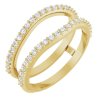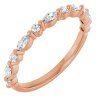Blue to blue-green aquamarine got its name from the Latin "aqua mare", meaning "sea water". Its specific colour resembles the surface of the sea. Aquamarine is the bearer of peace, purification, better relationships, and young love.

AQUAMARINE’S SYMBOLISM AND MYTHS
This gem has been valued since ancient times, and many stories are associated with it. The ancient Romans believed that aquamarine preserves the power of young love. It was one of the stones that a woman received as a gift from a man. In one ancient legend, we read that aquamarine comes from the treasury of mythical mermaids. Thanks to all these legends, aquamarine became the stone of sailors, which was supposed to protect them from drowning and give them courage when travelling on the sea.
MAIN AQUAMARINE DEPOSIT
Deposits of the breathtaking blue stone includes Brazil, Nigeria, Kenya, Russia and the United States of America. In Madagascar, it has a different, dark blue colouration..

AQUAMARINE IN JEWELLERY
This gemstone is a variety of beryl and belongs to the same category as emerald or morganite. It is characterised by considerable hardness, level 8 on the Mosh scale, and high gloss. It is very popular with grinders and jewellers. Buyers also like it, especially for its cleanliness, transparency, and ability to disperse light. Perhaps the most famous piece of jewellery with large Brazilian aquamarines was worn by the British Queen Elizabeth II, who received it as a coronation gift.
The shade of aquamarine makes it the perfect gem for lovers of light blue colours, especially for all those born in the month of March or under the sign of Cancer. Our goldsmith's studio also offers jewellery with aquamarines, for example, the REMI jewellery collection. This gem with the beautiful colour of the water surface can also be set into an original piece of jewellery that you design yourself using a 3D programme.

FAMOUS AQUAMARINE FINDS
Aquamarine weighing several tonnes is found only occasionally. It is rarely used for jewellery purposes because its colour tends to be cloudy in large finds. A pure blue aquamarine weighing 110.5 kg and measuring 48.5x41 cm was found in Brazil in 1910. One of the largest aquamarines cut in one piece was also found in Brazil, weighing 45 kg and 91 cm long. At the end, it was ground into the shape of an obelisk and named Dom Pedro. You can see it at the Smithsonian Institute, USA.









